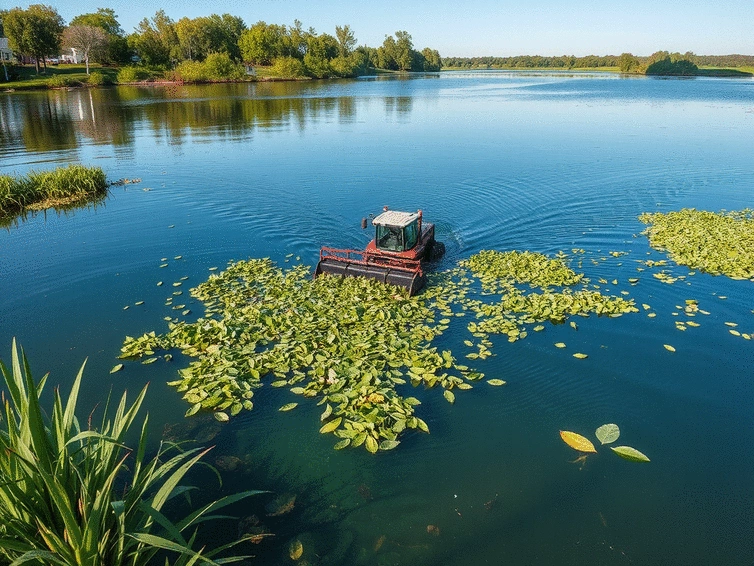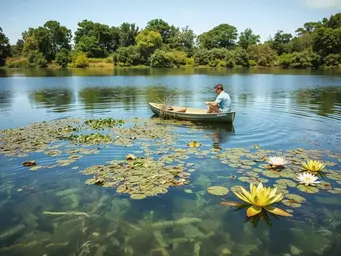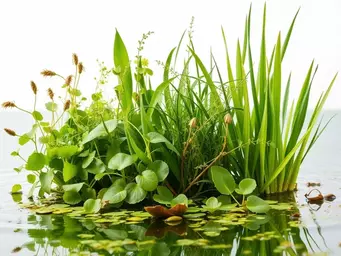Challenges Posed by Aquatic Weeds
- Oxygen Depletion
- Habitat Alteration
- Recreational Impacts
- Increased Nutrient Loads

As we dive into the world of aquatic weeds, have you ever wondered what lurks beneath the surface of our cherished lakes and rivers? These invasive species not only alter the landscape but also disrupt the delicate balance of aquatic ecosystems. By recognizing the various species of aquatic weeds, we empower ourselves to take action and restore harmony to our waterways.
Understanding the types of aquatic weeds and the mechanical methods for their control is crucial for maintaining healthy freshwater ecosystems. Below, we highlight key challenges and effective solutions.
As we look closer at the aquatic ecosystems that surround us, it becomes clear that understanding aquatic weeds is crucial for their management. There are various types of aquatic weeds that can affect ponds and lakes, each with its own characteristics and implications for water health. Identifying these weeds is the first step to taking control and preserving the delicate balance of our waterways!
In my journey as an ecologist, I have encountered a wide range of common aquatic weeds. These include:
By recognizing these species, we empower ourselves with the ability to manage them effectively. The next step is understanding the challenges posed by these aquatic weeds in freshwater ecosystems.

Being able to identify common aquatic weeds is essential for effective management. Each species has unique traits and behaviors, which can influence how they interact with their surroundings. For example, Hydrilla can grow in various environments and adapt quickly, making it a formidable opponent for waterway managers.
By familiarizing ourselves with these characteristics, we can develop practical strategies for managing these pesky invaders!
Now, let's discuss the real challenges that aquatic weeds bring to our freshwater ecosystems. These invasive plants can create significant problems, such as diminishing native plant life and disrupting aquatic habitats.
Understanding these challenges motivates us to take action toward effective management solutions that preserve our precious water resources.

The presence of invasive species significantly affects water quality, and it is crucial for us to recognize these impacts. For instance, excessive weed growth can lead to nutrient imbalances, which can exacerbate problems like algal blooms.
Managing these invasive weeds effectively is essential for maintaining water quality and securing healthy ecosystems for future generations!
Have you ever dealt with aquatic weeds in your local ponds or lakes? Share your experience and thoughts below:
In the realm of aquatic weed management, understanding the various mechanical methods available can empower you to make informed decisions for your ponds and lakes. As an ecologist, I've witnessed firsthand how effective these tools can be in restoring balance to our aquatic ecosystems. Mechanical methods not only enhance efficiency but also allow for precise control, especially in large areas plagued by invasive species.
It's essential to evaluate the specific needs of your waterway when selecting a mechanical approach. Each method has its advantages, allowing you to tailor your strategy based on the unique characteristics of your aquatic environment. For a deeper dive into the array of management techniques, you can explore resources on aquatic weed control methods and aquatic plant management techniques.
As we conclude this exploration of mechanical methods, let's highlight some key takeaways:
By implementing these strategies, you can play a significant role in maintaining the health and vitality of your waterways. Remember, proactive management is essential for preventing the resurgence of invasive species!
A1: Common aquatic weeds include Hydrilla, Water Hyacinth, Curly-leaf Pondweed, and Cattails. Each has unique characteristics and impacts on aquatic ecosystems.
A2: Aquatic weeds can lead to oxygen depletion, alter habitats for fish and other organisms, hinder recreational activities like swimming and boating, and increase nutrient loads in the water.
A3: Effective mechanical methods include Remote-Controlled Harvesters (like WaterGator and WaterBug), Lake Groomers, and Aquatic Weed Rollers. These tools offer efficient and precise control without chemicals.
A4: Identifying specific weed species (e.g., by visual traits, habitat, and seasonal variations) is crucial because each species may require a tailored management strategy for effective control.
A5: Proactive management, which involves assessing specific aquatic conditions, combining various control methods, and regular maintenance of equipment, is essential for preventing the resurgence of invasive species and ensuring long-term ecological balance.
As someone passionate about aquatic ecosystems, I encourage you to explore mechanical solutions tailored to your specific needs. Whether you're a landowner, ecologist, or waterway manager, there are practical tools available that can make a difference. Don’t hesitate to reach out to us at Aquatic Weed Solutions for guidance on selecting the right methods and tools for your situation!
Ultimately, finding the right balance of management techniques ensures that our lakes and ponds thrive, benefiting both wildlife and the communities that rely on these precious resources. Let's work together to safeguard our aquatic environments!
Here is a quick recap of the important points discussed in the article:
Managing Aquatic Weeds Effectively

As we delve into the hidden challenges of our water ecosystems, understanding the role of aquatic we
Impact of Aquatic Weeds on Recreation

As we dive into the world of aquatic ecosystems, the presence of invasive aquatic weeds may not only
Understanding Aquatic Weed Varieties

What if understanding aquatic weeds could be the key to restoring our waterways? As we dive deeper i
Managing Aquatic Weeds Effectively
Impact of Aquatic Weeds on Recreation
Understanding Aquatic Weed Varieties
Integrated Aquatic Weed Management Methods
Integrated Approaches to Aquatic Weeds